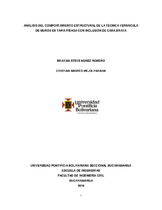Mostrar el registro sencillo del ítem
Análisis del comportamiento estructural de la técnica vernácula de muros en tapia pisada con inclusión de caña brava
| dc.contributor.advisor | Director. Pineda Vargas, Sergio Manuel | |
| dc.contributor.author | Núñez Romero, Brayam Steve | |
| dc.contributor.author | Mejía Parada, Cristian Andrés | |
| dc.coverage.temporal | 2018 | |
| dc.date.accessioned | 2020-04-15T16:10:48Z | |
| dc.date.available | 2020-04-15T16:10:48Z | |
| dc.date.issued | 2018 | |
| dc.identifier.uri | http://hdl.handle.net/20.500.11912/5181 | |
| dc.description | 98p.: (pdf); il; imágenes; tablas. | spa |
| dc.description.abstract | La tapia pisada ha venido tomando gran auge debido a sus virtudes y a la concientización ambiental de los últimos años. Sin embargo, estos sistemas constructivos no cuentan con suficientes investigaciones que caractericen su comportamiento estructural. De esta manera, detalles constructivos corno los que se implementan en Santander en donde se incluye caña brava (Gynerium sagittatum) en muros de tapia pisada, no han sido estudiados ampliamente y se confía solo en la tradición empírica de las personas que realizan esta labor. Esta investigación ha traído este conocimiento empírico a la academia y ha analizado el aporte estructural real de la caña brava a este tipo de estructuras, en aras de proporcionar un aval teórico y científico a la aplicación de este proceso constructivo. Para el desarrollo de esta investigación se construyeron dos pares de muros, en donde el primer par tenla la técnica tradicional de tapia pisada y el segundo par contaba con inclusión horizontal de caña brava. A estos muros se les practicó un ensayo de carga cíclica pseudo•estática con ciclos de carga controlados por deflexiones. Con los datos obtenidos se realizaron gráficas de histéresis, las cuales mostraron el comportamiento de los elementos de estudio. Este comportamiento está dado por la envolvente de carga, la cantidad de disipación de energía y la degradación de la rigidez de la estructura. Con estos resultados se observó que los muros con inclusión de caña brava disipan un 70% menos de energía que los construidos en la técnica de tapia pisada convencional según el protocolo desarrollado. Por este motivo se puede concluir que la caña brava dispuesta en sentido horizontal está perjudicando la entereza del elemento y no es recomendable utilizar este tipo de inclusión, por cuanto crea planos de fallas en la estructura y acelera el proceso de deterioro de esta. | spa |
| dc.description.abstract | The rammed earth technique is making a big impact nowadays because of its advantages and the environment awareness embraced in the latest years. Although, those kinds of constructions do not have enough research that show clues about its behavior under seismic effects and general structural performance. Thus, constructive details like the one that take place at the Department of Santander, in which reed (Gynerium sagittatum) is introduced in rammed earth walls, had not been studied properly and the details are just trust by the empirical tradition implemented by the workers of those techniques. The research brought this empirical tradition to academic field and analyzed the real structural contribution of the reed in this kind of structures, for the sake of supply a theoretical and scientific guarantee for this constructive process. For the development of this research, two pairs of rammed earth walls were built The first pair were rammed earth walls without inclusion of other materials, the second pair had a horizontal inclusion of reed. A quasi static cyclic test was implemented on the walls, with a controlled push & pull load cycle by drift ratios. With the gathered data, hysteresisV graphics were made and the curves show the behavior of the studied elements. This behavior is shown by the load envelope curve, the dissipated energies and the stiffness degradation of the structure. The results show that the walls with the inclusion of reed dissipates 70% less energies than the ones who were built with the common rammed earth technique. For this reason, the main conclusion here is that the reed inclusion in horizontal direction cause harm to element integrity and it is not suitable using this sort of technique, because creates fault plans in the structure and speed up the wall's degradation process. | eng |
| dc.format.mimetype | application/pdf | |
| dc.language.iso | spa | |
| dc.publisher | Universidad Pontificia Bolivariana | spa |
| dc.rights | Attribution-NonCommercial-NoDerivatives 4.0 International | * |
| dc.rights.uri | http://creativecommons.org/licenses/by-nc-nd/4.0/ | * |
| dc.subject | Adobe | spa |
| dc.subject | Histéresis | spa |
| dc.subject | Muros | spa |
| dc.subject | Estabilidad de estructuras | spa |
| dc.title | Análisis del comportamiento estructural de la técnica vernácula de muros en tapia pisada con inclusión de caña brava | spa |
| dc.type | Trabajo de grado | spa |
| dc.publisher.department | Escuela de Ingenierías | spa |
| dc.publisher.program | Ingeniería Civil | spa |
| dc.type.hasVersion | publishedVersion | spa |
| dc.description.sectional | Bucaramanga | spa |
| dc.description.degreename | Ingeniero Civil | spa |
Ficheros en el ítem
Este ítem aparece en la(s) siguiente(s) colección(ones)
-
Trabajos de grado [6691]
Monografías, artículos, informes, proyecto de grado


